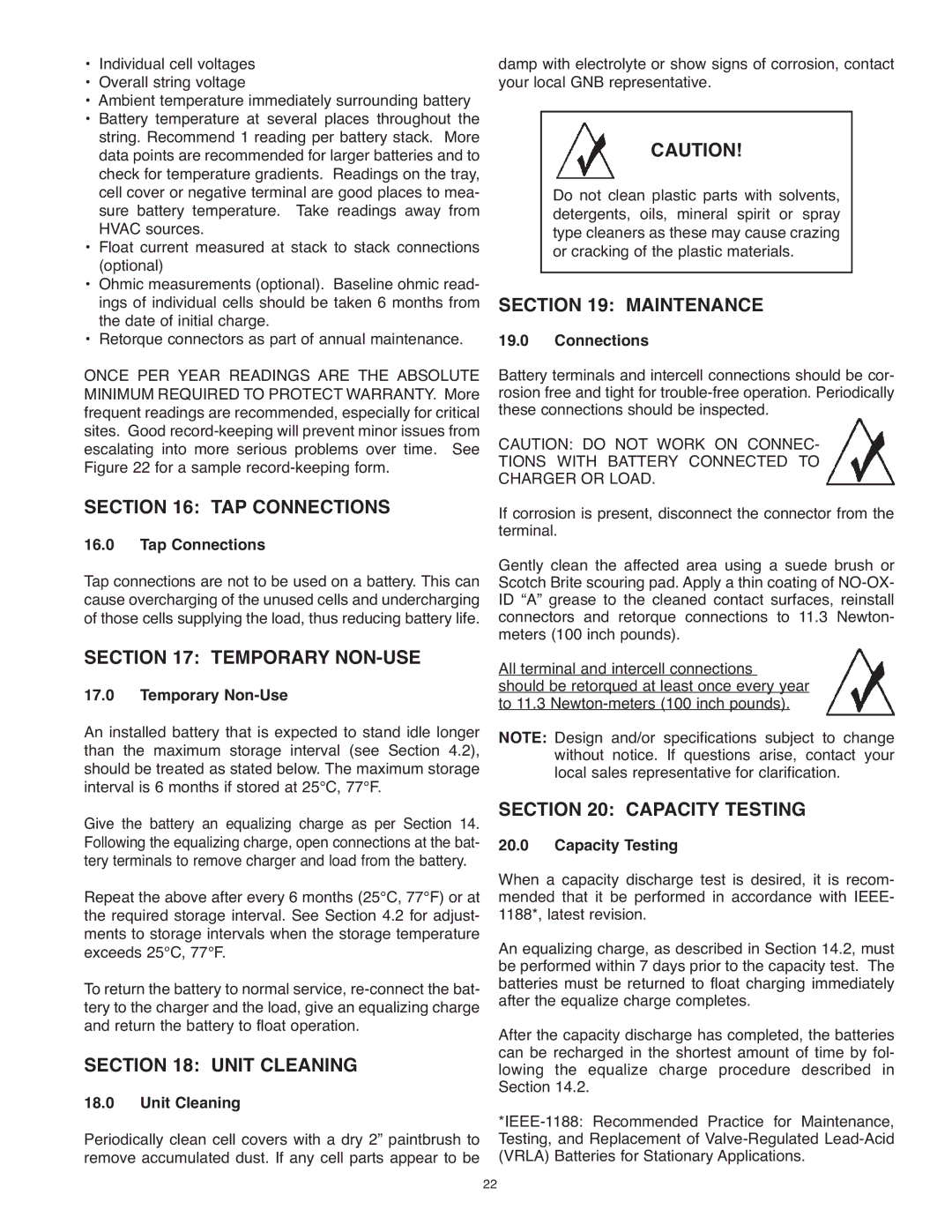
• Individual cell voltages
• Overall string voltage
• Ambient temperature immediately surrounding battery
• Battery temperature at several places throughout the string. Recommend 1 reading per battery stack. More data points are recommended for larger batteries and to check for temperature gradients. Readings on the tray, cell cover or negative terminal are good places to mea- sure battery temperature. Take readings away from HVAC sources.
• Float current measured at stack to stack connections (optional)
• Ohmic measurements (optional). Baseline ohmic read- ings of individual cells should be taken 6 months from the date of initial charge.
• Retorque connectors as part of annual maintenance.
ONCE PER YEAR READINGS ARE THE ABSOLUTE MINIMUM REQUIRED TO PROTECT WARRANTY. More frequent readings are recommended, especially for critical sites. Good
SECTION 16: TAP CONNECTIONS
16.0 Tap Connections
Tap connections are not to be used on a battery. This can cause overcharging of the unused cells and undercharging of those cells supplying the load, thus reducing battery life.
SECTION 17: TEMPORARY NON-USE
17.0 Temporary Non-Use
An installed battery that is expected to stand idle longer than the maximum storage interval (see Section 4.2), should be treated as stated below. The maximum storage interval is 6 months if stored at 25°C, 77°F.
Give the battery an equalizing charge as per Section 14. Following the equalizing charge, open connections at the bat- tery terminals to remove charger and load from the battery.
Repeat the above after every 6 months (25°C, 77°F) or at the required storage interval. See Section 4.2 for adjust- ments to storage intervals when the storage temperature exceeds 25°C, 77°F.
To return the battery to normal service,
SECTION 18: UNIT CLEANING
18.0 Unit Cleaning
Periodically clean cell covers with a dry 2” paintbrush to remove accumulated dust. If any cell parts appear to be
damp with electrolyte or show signs of corrosion, contact your local GNB representative.
CAUTION!
Do not clean plastic parts with solvents, detergents, oils, mineral spirit or spray type cleaners as these may cause crazing or cracking of the plastic materials.
SECTION 19: MAINTENANCE
19.0 Connections
Battery terminals and intercell connections should be cor- rosion free and tight for
CAUTION: DO NOT WORK ON CONNEC- TIONS WITH BATTERY CONNECTED TO CHARGER OR LOAD.
If corrosion is present, disconnect the connector from the terminal.
Gently clean the affected area using a suede brush or Scotch Brite scouring pad. Apply a thin coating of
All terminal and intercell connections
should be retorqued at least once every year to 11.3
NOTE: Design and/or specifications subject to change without notice. If questions arise, contact your local sales representative for clarification.
SECTION 20: CAPACITY TESTING
20.0 Capacity Testing
When a capacity discharge test is desired, it is recom- mended that it be performed in accordance with IEEE- 1188*, latest revision.
An equalizing charge, as described in Section 14.2, must be performed within 7 days prior to the capacity test. The batteries must be returned to float charging immediately after the equalize charge completes.
After the capacity discharge has completed, the batteries can be recharged in the shortest amount of time by fol- lowing the equalize charge procedure described in Section 14.2.
22 (VRLA) Batteries for Stationary Applications.
